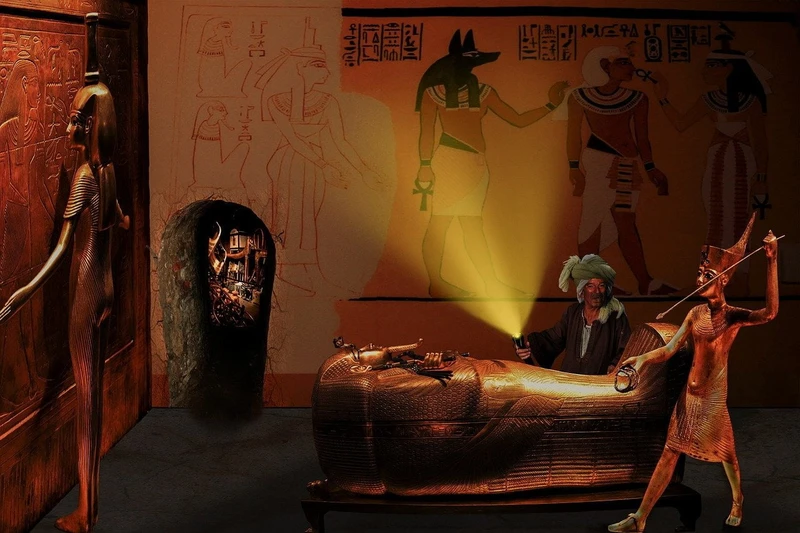Tutankhamun is one of the most famous pharaohs of Ancient Egypt. He ruled 3000 years ago, ascending to the throne at the age of 9 or 10 and dying at 18. The likely cause of Tutankhamun’s death remains unknown. For a long time, it was believed that the ruler succumbed to malaria, which he contracted through an open wound. However, according to modern research, the theory regarding the death of the most famous of all pharaohs may be quite different.
Egyptologist Sofia Aziz has put forward a rather controversial new theory about how the young pharaoh may have died. In her opinion, Tutankhamun was a typical example of “golden youth.” He might have been involved in a chariot accident while driving under the influence. This could have led to a leg fracture, which then became infected with a deadly infection.
How did it all begin?
The tomb of Tutankhamun was discovered in the Valley of the Kings by Egyptologist Howard Carter in 1922. Several months were spent cataloging the antechamber. The burial chamber and sarcophagus were found and opened in 1923. It took another 10 years to clear the tomb of the numerous treasures and items that were buried with the ruler’s mummy.

The Mask of Tutankhamun
Since then, the tomb of Tutankhamun has become one of the most studied sites, and the figure of the ruler sparks considerable debate among researchers. In 2010, a group of Egyptologists conducted the most extensive radiological study of the pharaoh’s mummy. The main goal was to determine the causes of Tutankhamun’s early death.
According to previous research, scientists claimed that the pharaoh must have relied on a cane while walking due to a severe illness known as Kohler’s disease. Additionally, he had a clubfoot on his left foot and fewer than five toes on his right. However, researchers concluded that Tutankhamun was not killed by all these ailments, but rather by a broken leg. The reason why the ruler might have broken his leg remains unknown to scientists.
Not a disabled person, but a true warrior.
Currently, Ms. Aziz completely refutes previous conclusions regarding the disability of the famous pharaoh. To support her claims, the researcher uses items found in the tomb. As is known, in Ancient Egypt, the deceased were buried with everyday objects that could be useful in the afterlife.
Ms. Aziz points out the presence of six chariots, armor, and wine storage in the tomb of Tutankhamun. According to the researcher, these items indicate that the young ruler was not disabled and rode chariots like a “warrior pharaoh.”
The Egyptologist believes that during his reign, Tutankhamun struck the edge of his chariot. In her opinion, this is what led to life-threatening injuries. According to Ms. Aziz, the previously noted clubfoot of the young ruler actually did not exist.
The researcher believes that this distortion occurred during the mummification process of the body, rather than during the pharaoh’s lifetime. As Ms. Aziz noted to the publication. Daily Mail The reason for this is tight bandaging and the use of resin.
Moreover, the appearance of the well-aligned legs of the ancient Egyptian ruler’s mummy also supports this conclusion. As Ms. Aziz points out, if Tutankhamun had foot deformities and was bow-legged, it would have been difficult for him to walk. However, the long, straight bones clearly refute these assumptions.
The researcher claims that she has seen many mummies with clubfoot. In the case of Tutankhamun, there is no evidence that he was disabled. According to Ms. Aziz, canes may be a sign of royal authority rather than proof of the ruler’s disability.

Who knows how it really was?
Despite the claims of the Egyptologist, Professor Albert Zink, who participated in the landmark study of 2010, believes his conclusions are still valid. In his opinion, the computer tomography clearly indicates foot deformity and the presence of other leg diseases in Tutankhamun.
There is no doubt that the ruler of Ancient Egypt had a walking impairment, particularly due to bone necrosis. However, Professor Zinc does not rule out the possibility that Tutankhamun may have sustained a serious injury while moving in a chariot.
Although the statement about the pharaoh driving a chariot while intoxicated raises doubts for Mr. Zinka, the professor adds that considering the advanced stage of bone necrosis in Tutankhamun’s foot, it is hard to imagine that he could have stood while riding in a chariot. At the same time, the pharaoh did indeed have a leg fracture, but it is impossible to determine the exact cause of the injury.
Partially, Ms. Aziz acknowledges the validity of Professor Zink’s claims. According to the researcher, we may never know exactly how the most famous pharaoh of Ancient Egypt died. Only certain discoveries regarding the condition of the ruler’s internal organs may provide a bit more information on this matter.
